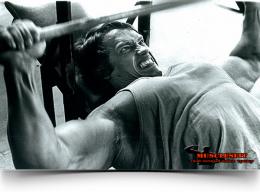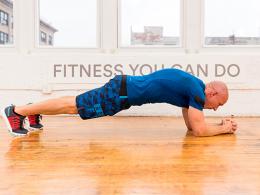How to properly pump up your triceps - mistakes and solutions
The triceps, like the blue-collar big brother, toils in obscurity in the shadow of its little brother the biceps, carrying its own load and providing assistance to the other muscles (chest and shoulders). In fact, the triceps are a larger muscle group than the biceps, and therefore, they need to be given special, “correct” attention. So how to properly pump up your triceps? Below you will find 5 main mistakes made when training triceps and, of course, new and effective ways to pump it.
#1 Not using all three heads of the triceps enough
As the name suggests, the triceps consists of three heads: long (upper inner), medial (lower inner) and lateral (outer). All three areas of the triceps always work together, so it is impossible to isolate one from the other. However, the angle of the palms changes the emphasis, loading the heads differently. Many athletes do not know how different exercises pump their triceps and, thus, they overestimate their lateral part and underestimate their long and medial parts. Therefore, in order to properly pump up your triceps, Appropriate grips must be used.
- With a straight and neutral grip (extension on a block), the lateral parts are loaded to a greater extent.
- When the grip is reversed, the medial parts are worked more strongly. In fact, regardless of arm position, the medial heads are engaged in all triceps exercises as soon as the arms are fully extended. But to properly pump up the medial heads, be sure to include “reverse grip cable extensions” in your workout.
- When the forearms are moved overhead (French presses), the long heads are loaded.
#2 Ineffective exercise order
There is no wrong order of exercises! However, it may not be effective. Changing their order can “shock” the triceps, which means pushing it to grow. For example, this is performing an isolating exercise first, after which you move on to the basic one. However, try to start most of your workouts with exercises where you can place the most stress on your triceps with the most resistance. Executing the "base" at the very beginning of your training, at the moment when you are strongest, will allow you to properly and effectively pump up your triceps.
- Do the basic exercises first, such as close-grip barbell presses and dips.
- Then move on to double arm extensions with free weights.
- Finish the program with one-arm or cable exercises.
- You can change the order of exercises to overcome plateaus, but stick to this order for the majority of your triceps workouts.
#3 Paying too much attention to exercise equipment
Many athletes rely too much on various machines, including cable curls, to build their triceps. For example, bodybuilders often include 4 sets of “V-bar and rope extensions” in their triceps training program. But these two similar exercises stress the triceps in an almost identical way, emphasizing your laterals.
- Do compound exercises (which also work the chest and shoulders) in every triceps workout. Examples include “close-grip barbell press,” “dips,” and “vertical push-ups.”
- Do at least one triceps exercise with a curved bar or dumbbell. These could be “French bench presses with a curved bar” and “one-arm overhead extension with a dumbbell.”
- If you are doing two exercises on the block, then one should be performed with an overhand or neutral grip (to emphasize the lateral parts), and the other with a reverse grip (to emphasize the medial sides).

#4 Incorrect technique
To properly pump up the triceps and concentrate the load on it as much as possible, you need to lock your elbows in place. As soon as you begin to move your elbows forward, backward, or outward, you are transferring some of the load to your shoulders. This allows you to use more weight or do more reps, but it makes it easier on the triceps instead of targeting the triceps exclusively.
- Lock your arms in place for all reps until you reach failure. For example, when performing “block extensions”, it is enough to press them to the body and not allow them to deviate from this position.
- Once you reach the point of failure with strict form, you can relax your form to allow for a few extra reps. This can be done by moving your elbows slightly forward during the negative part of the repetition and back during the positive part.
#5 Overtraining
Unlike other muscle groups, triceps are the most prone to overtraining. Most bodybuilders know that the triceps are larger than the biceps, so in pursuit of arm size, they believe that if they do 12 sets for the biceps, it is only logical to do more sets for the larger muscle group. In addition, unlike the biceps, which only help when training the back muscles, the triceps provide indispensable support when training the chest and shoulder muscles. If you train your chest, shoulders and triceps on different days, then Your Triple Muscle Gets a Triple Hit and probably doesn't get enough time to recover.
- Compared to other large muscles, such as the back and chest, the triceps is a small muscle. As a rule, to pump up the triceps, 12 approaches will be enough. If you're using a chest/triceps or shoulder/triceps split, consider doing even fewer sets of triceps because they've already received some load during the presses.
- Rest should be a minimum of 48 hours, and ideally 72 hours, between training your chest or shoulders and training your triceps. Use the appropriate split.
- Engage different areas of the triceps - long, lateral and medial.
- As a general rule, do the base first, then move to free weights using two arms before moving on to one-arm exercises and cable machines.
- Be sure to include free weights on your triceps day.
- Lock your elbows in place until you reach muscle failure.
- Perform no more than 12 triceps sets per workout, and always rest at least two days between the chest or shoulder workout and the triceps workout.
Triceps training program
This triceps training program can be included in your split in several ways: 1) After bench presses, i.e. after chest or shoulders 2) Set aside a day for arm training, i.e. biceps along with triceps 3) Set aside a day to train triceps alone.
NOTE: For the first and last exercises, increase the weight with each set.






